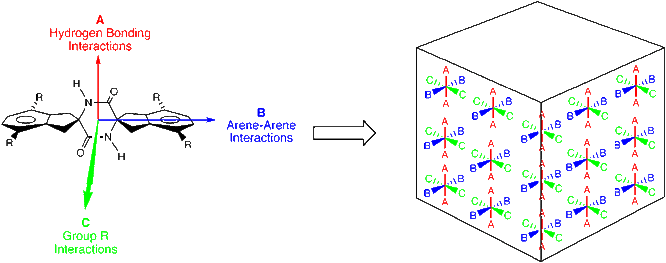

43745-AC4
Hydrocarbon, Fluorocarbon, and Mixed Hydrocarbon/Fluorocarbon Liquid Crystalline Materials from Predictable Supramolecular Assembly of Piperazine-2,5-Diones
2008 NARRATIVE REPORT
Our program in crystal engineering (CE) seeks to harness intermolecular interactions for the design and production of novel molecules that exhibit useful bulk properties. We are employing a piperazinedione-based molecular scaffold (see Figure 1) to explore the effects of the aryl appendages R on the crystal packing and bulk properties of such molecules. Our working hypothesis has been the crystal packing of symmetrically substituted tetra-n-alkoxypiperazinediones 1 will be governed by (1) assembly of these molecules into "one-dimensional" tapes through establishment of reciprocal amide hydrogen bonds, (2) assembly of the tapes into "two-dimensional" grooved sheets through establishment of edge-to-face arene interactions, and (3) assembly of the sheets into "three-dimensional" solids by "tongue-in-groove" interdigitation of the n-alkyl "tails" in extended conformations, independent of chain length. Liquid crystal (LC) properties would be expected for compounds bearing alkyl groups of sufficient length. We proposed to complete the study of tetra-n-alkoxypiperazinediones 1 and to expand the study to include symmetrically substituted tetra-n-perfluoroalkylpiperazinediones 2 and hybrid hydrocarbon/fluorocarbon piperazinediones 3 and 4 with a goal of developing novel fluorocarbon and mixed hydrocarbon/fluorocarbon liquid crystalline materials.
Figure 1. A piperazinedione
scaffold incorporating three geometrically and chemically independent
recognition elements might assemble predictably into a solid.
We
have completed the syntheses of the series of compounds 1 with n = 1, 2, 4, 6, 8, 9, and 12. The thermochemical properties of
molecules 1 have been studied, and
they do exhibit LC phase transitions as expected. Crystallography for the compounds 1 with n = 1, 2, 4, and 12 has been completed. Crystals of the compounds 1 where n = 6, 8, and 9 were sent in
September 2007 to Service Crystallography at the Advanced Light Source (SCrALS) for data collection using synchrotron
radiation. This was necessary due
to the small size of the crystals.
Unfortunately, none of the crystals submitted was sufficiently
diffracting for collection of data.
We continue to try to grow crystals of 1 where n = 6, 8, and 9 suitable for crystallographic study. Submission
of a full paper disclosing our results with compounds 1 is being held pending additional crystallographic data.
Work
toward the syntheses of tetra-n-perfluoroalkylpiperazinediones
2b by the route depicted in Scheme 1
has been halted. Tetrabromide 5
was prepared from known a,a',3,6-tetrabromo-o-xylene via coupling of amino ester 6 with BOC acid 7 and thermally induced cyclization of
the resulting dipeptide 8. An
X-ray crystal structure analysis of 5
has been completed. However,
copper mediated coupling of tetrabromide 5
with perfluorohexyl and perfluorooctyl
iodides did not provide 2f or 2h. Rather, mixtures of the dibromo-di(perfluoroalkyl)substituted
and (mostly) monobromo-tri(perfluoroalkyl)substituted
intermediates precipitate from solution, thwarting complete replacement of the
bromine substituents.
Scheme 1.
Synthetic Approach to 2a-2j Attempts to couple shorter perfluoroalkyl
chains into the tetrabromide 5 via decarboxylation of perfluoroalkylcarboxylates also met with failure. Introduction of two perfluorooctyl
chains into the Boc derivative of 6 by copper mediated coupling with perfluorooctyl iodide was successful, but subsequent
attempts to advance the synthesis of 2h
by deprotection to the amino ester and Boc acid components, peptide coupling, and thermolysis met with low yields and failure, respectively,
at the deprotection and peptide coupling steps for
reasons of compound insolubility.
In light of the above results, our attention has turned to making hybrid
hydrocarbon/fluorocarbon piperazinediones 9a-j as depicted in Scheme 2.
Scheme 2.
Synthetic Approach to 9a-9j



